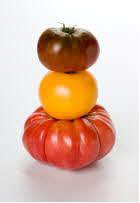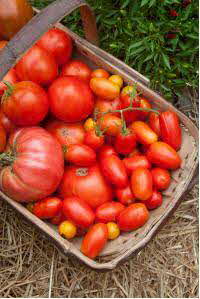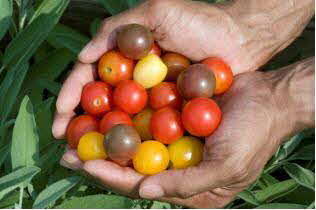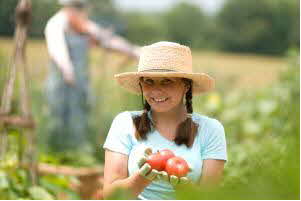TOMATO VARIETIES THAT CAN TAKE THE HEAT
|
|
Tomato Terms, Tips and Types
Tomatoes are the most popular vegetable in home gardens across America; most gardeners agree nothing tastes better than a home-grown tomato! It’s important to understand common tomato terms, often seen on tomato plant tags and the basics of growing tomatoes…. the more you know the better you’ll grow. Now through mid-July, you can plant extra tomatoes for later harvests in fall, often right up to frost dates if you protect them overnight or harvest them green and ripen them indoors.

Tomatoes need the right combination of good soil, water and heat. Use transplants, like Bonnie Plants, they’re faster than starting from seed and easier to grow. Transplants offered in biodegradable pots are planted directly in-ground, preventing transplant shock and saving millions of pounds of plastic from landfills. Find a sunny location (at least 6 hours of sun) with good drainage, and if you plant tomatoes each season, it’s a good idea to rotate the spot in the garden where you plant them.
Terms
Tomato plants are classified as either indeterminate or determinate.
Indeterminate plants grow all season, continuing to bloom and produce fruit as long as weather conditions are favorable. (Bonnie Better Boy, Bonnie Original, Early Girl, Sweet 100, Sun Sugar)
Determinate plants are the compact bush type, like Better Bush, they grow to a certain size, set fruit, and stop growing, bearing fruit all at once. This type of tomato is popular with gardeners who like to can and make sauce. (Better Bush, Bush Goliath, Patio, Roma, Solar Fire, Sweet and Neat, Husky Red).

Tomatoes are often designated by the terms early, middle and late, which refer to when the fruit will be ready to harvest. Early season tomatoes are the first to ripen, late season are the last to ripen and middle season types fall somewhere in between. Planting some of each type is a good strategy for enjoying ripe tomatoes throughout the summer.
Tomato Types
Heirloom tomato - Any tomato that is at least fifty years old and is not a hybrid, like “Mortgage Lifter”, this heirloom tomato got its name because a mechanic in West Virginia who developed the variety made so much money selling the seeds he paid off his mortgage! (Arkansas Traveler, Black Krim, Cherokee Purple, German Queen, Mr. Stripey)
Hybrid tomato - A tomato bred by crossing varieties. Hybrids offer better disease resistance, higher yield, and other improved traits. (Juliet, Bonnie Original, Big Boy, Summer Set, Tami G)

Now it’s time to pick your plants: While tomato lovers have a seemingly endless list of varieties to plant in their gardens, tomatoes fall into three basic categories: small salad (cherry) tomatoes, slicing tomatoes and thick-walled tomatoes ideal for making sauces. It can be confusing to pick the perfect tomato best suited for your needs; you might want to check out the “Tomato Chooser” on Bonnie Plants website ...you can sort through tomato varieties to find just what you want, if you check off the traits that you’re looking for, the Tomato Chooser will do the work for you, bringing up all the varieties that match.
If you’re temperatures are rising, and most are, choose a heat-set tomato variety that’s able to set fruit in high temperatures compared to many other varieties. You might try Arkansas Traveler, Florida 91, Husky Red Cherry, or Super Sweet 100. For these and other heat set variety descriptions see bonnieplants.com/products/vegetables/tomato-varieties/heat-tolerant
|
Planting Tomatoes Step-by-Step
1. Prepare your plot: Loosen the ground to create a welcoming bed for roots to grow. You can add 3 or 4 inches of compost or other organic matter, especially in clay or sandy soils. Then dig a hole that is as deep as the plant is tall because you are going to bury two-thirds of the plant.
2. Slip Plant from pot if in plastic: Gently remove the plant by slipping the plastic container from the root-ball. Don’t tug on the plant stem; this can sever it from the roots. If the roots are growing out of holes in the bottom of the pot, tear or cut them away and squeeze and twist the pot as necessary to work it from the roots. If your plant is in a biodegradable pot, just tear off the bottom of the pot to make sure that roots are in instant contact with the soil.
3. Bury Two-thirds of the plant: Set the plant in the hole deeply enough so that two-thirds of it is buried. Roots will sprout all along the buried stem to make a stronger plant. You can pinch off the lower leaves if you prefer, but it is not necessary.

4. Don’t forget to fertilize: Mix fertilizer into the soil that you will put back into the hole. It is best to fertilize according to recommendations from a soil test, but if you don't have that, use a timed-release fertilizer, which doesn't leach...or use an organic fertilizer at the rate recommended on the label. Bonnie's Vegetable and Herb Plant Food is a natural fertilizer and the same liquid food that Bonnie uses to grow plants in greenhouses across the country. Tomatoes love it.
Your tomato plant is almost ready to grow--When you’re done, two-thirds of the entire plant will be buried; only the top of the tomato plant remains above ground.
5. Water Well: Water thoroughly at soil line. This is very important to help settle the soil and start the plant.
6. Maintain your mulch: Mulch with pine needles, straw, or compost to help keep moisture in the soil and prevent weeds. Mulch should be 2 to 3 inches deep for effective weed control.
Plant tomatoes that work for you, they’re fun to grow and the taste of a home-grown tomato is definitely more delicious than any store bought tomato. Enjoy the fruits of your labor!!
RELATED ARTICLES:
Please feel free to link to any pages of FoodReference.com from your website.
For permission to use any of this content please E-mail: james@foodreference.com
All contents are copyright © 1990 - 2014 James T. Ehler and www.FoodReference.com unless otherwise noted.
All rights reserved.
You may copy and use portions of this website for non-commercial, personal use only.
Any other use of these materials without prior written authorization is not very nice and violates the copyright.
Please take the time to request permission.
CULINARY SCHOOLS &
COOKING CLASSES
From Amateur & Basic Cooking Classes to Professional Chef Training & Degrees
More than 1,000 schools & classes listed for all 50 States, Online and Worldwide
FREE Food & Beverage Publications
An extensive selection of free magazines and other publications for qualified Food, Beverage & Hospitality professionals


